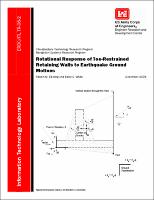Please use this identifier to cite or link to this item:
https://hdl.handle.net/11681/10944| Title: | Rotational response of toe-restrained retaining walls to earthquake ground motions |
| Authors: | Infrastructure Technology Research Program (U.S.) Navigation Systems Research Program (U.S.) Ebeling, Robert M., 1954- White, Barry C. |
| Keywords: | Displacement Dynamic earth pressures Earthquake ground motions Earth retaining structures CorpsWallRotate Rotation Seismic Soil dynamics Soil mechanics Translation Retaining walls |
| Publisher: | Information Technology Laboratory (U.S.) Engineer Research and Development Center (U.S.) |
| Series/Report no.: | ERDC/ITL TR ; 06-2. |
| Description: | Technical Report Abstract: This research report describes the engineering formulation and corresponding software developed for the rotational response of rock-founded, toe-restrained Corps retaining walls to earthquake ground motions. The PC software CorpsWallRotate (sometimes referred to as CWRotate) was developed to perform an analysis of permanent wall rotation for each proposed retaining wall section to a user-specified earthquake acceleration time-history. A particular formulation of the permanent sliding (i.e., translational) displacement response of retaining walls is also described. The resulting engineering methodology and corresponding software are applicable to a variety of retaining walls that are buttressed at their toes by a structural feature (e.g., navigation walls retaining earth, spillway chute walls, spillway discharge channel walls, approach channel walls to outlet works structures, highway and railway relocation retaining walls, and floodwall channels). CorpsWallRotate is particularly applicable to L-walls and T-walls (cantilever retaining walls) and may also be used to predict permanent, seismically induced displacements on retaining walls with or without a toe restraint. Formal consideration of the permanent seismic wall displacement in the seismic design process for Corps-type retaining structures is given in Ebeling and Morrison (1992). The key aspect of the engineering approach presented in this 1992 document is that simplified procedures for computing the seismically induced earth loads on Corps retaining structures are also dependent upon the amount of permanent wall displacement expected to occur for each specified design earthquake. The Ebeling and Morrison simplified engineering procedures for Corps retaining structures, including waterfront retaining structures, are geared towards hand calculations. The engineering formulation and corresponding PC software CorpsWallRotate discussed in this report extend simplified procedures to walls that rotate or slide during earthquake shaking and make possible the use of acceleration time-histories in the Corps’ design/analysis process when time-histories are made available on Corps projects. The engineering methods contained in this report and implemented within CorpsWallRotate allow the engineer to rapidly determine if a given retaining wall system has a tendency to rotate or to slide for a specified seismic event. |
| Rights: | Approved for public release; distribution is unlimited. |
| URI: | http://hdl.handle.net/11681/10944 |
| Appears in Collections: | Technical Report |
